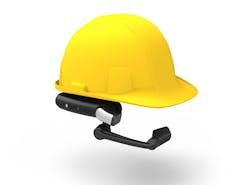The industrial wearables market is a fast-growing one, not just because of its practical appeal, but in the way it captivates us with its factory of the future look and feel. Even focusing on the real-world growth potential of this market is captivating. According to Market Research Engine, the global wearable devices market is expected to exceed more than $51 billion by 2022, growing by roughly 15 percent each year between now and then.
When it comes to the industrial wearables market, it tends to be the hardware that captures our attention first and foremost—the hardhat with the eyepiece, the watch, the immersive headset, etc. But like every other technology, while the exterior may catch the eye, it’s the software inside that delivers the goods.
That’s where Tacit is focusing its technology development for the industrial wearables market. As Todd Boyd, founder and president of Tacit, says, “We have hardhat and watch devices, but we’re not in the hardware business. Some of the hardware Tacit features for use with its software come via its relationships with Daqri (a supplier of artificial intelligence software and smart glasses), and realwear (a supplier of rugged headset vision devices that fit inside hardhats). Boyd was also involved in the launch of both of these companies.
Boyd clarifies Tacit’s focus by noting that the company concentrates on “enabling software compatibility across wearable devices and bringing artificial intelligence [AI], machine learning [ML] and natural language processing to the industrial wearables market.”
Tacit currently offers its Tacit App Suite of software, which includes Data Capture-in-Context (i.e. tagging data to an asset); Remote Mentor to help users quickly access a common understanding of a problem; Data Visualization; Dynamic Workflow; and Content Search and Management.
The company has also created the Tacit Intelligent Services Hub, which Boyd says is designed to be an industrial app store for its software as well as third party products that work across devices. “Integration of apps here is handled by industry standard connectors and REST APIs, an open plug-and-play architecture and deployment on a secure, scalable, industry cloud infrastructure,” says Boyd.
At the OSIsoft conference this past spring, Tacit demonstrated how its software can be used to bring OSIsoft PI Vision’s historic and real-time data to realwear’s hmt-1 headset. Tacit has also partnered with Samsung to bring Tacit software to Samsung’s ruggedized tablets and provide notifications on Samsung’s Gear S3 watch.
“Our value proposition is delivery of an intuitive, easy user experience—one that’s simple to use, understands what the worker needs in context, and which has cross-device compatibility [Android or iOS] through an open ecosystem to make it easier for companies to leverage existing software and hardware investments,” says Boyd.
He adds that Tacit doesn't really see its technology as being a type of augmented or virtual reality. “It’s more pragmatic,” says Boyd. “In the hmt-1 headset, for example, we use an opaque display, so it’s not a fully immersive experience. It’s all about hands-free access to information while you’re doing your job.”
Industrial verticals Tacit focuses on are those with a high cost of downtime, such as oil and gas, power and utilities, supply chain and discrete manufacturing. Some industrial companies currently exploring Tacit’s technology include Dow Chemical, Flint Hills Resources, Takenaka and Norfolk Southern, says Boyd.
About the Author
David Greenfield, editor in chief
Editor in Chief

Leaders relevant to this article:
